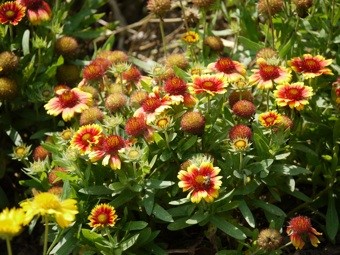Gaillardia pulchella: Indian Blanket Flower
 Latin name: Gaillardia pulchella
Latin name: Gaillardia pulchella
Common name: Indian Blanket Flower
Flowers: Red and/or yellow flowers 19, June to frost bloom time 12 10 Fruit: Not showy 12
Height & Width: 1’-1.5’ h x 0.5’-1’ w 12
Type: Annual 19
Habit: Groundcover 19
Wetland indicator category**: UPL 17
(SC regions include (1) Atlantic and Gulf Coastal Plains & (2) Eastern Mountain Piedmont)
Texture: Fine 12
Growth rate: Medium 19
Light: Full sun 19
Moisture: Dry-Medium, drought tolerant 12
Soil*: Acidic, slightly acidic, slightly alkaline, alkaline19, sand, loam19
Zones: 2-11 12
Origin: Eastern and south-central United States, Mexico 12
Ecosystem benefits: Attracts birds and butterflies 12
Features: This plant attracts birds and butterflies12, and has attractive red and/or yellow flowers12.
Siting: This plant is good in large garden beds or in containers in full sun12.
Care: Plant crown at soil level18. At planting, water the roots and surrounding area slowly and deeply. Keep soil moist until plant is established, then apply enough water to thoroughly moisten the root zone when the soil is dry or during drought. Modify water recommendations to reflect site drainage and rainfall. Apply 3” of mulch over the planted area. Do not allow mulch to touch the plant stems18.
Pests: : Plants are relatively pest resistant if cultural preferences are met12, root rot can occur during prolonged periods of rain when in poorly draining soil12, watch for thrips and aphids12.
This plant does not appear on the following invasive plant lists on 02/07/2022:
USDA SC Invasive Plant Species
SC Exotic Plant Pest Council
Author: Kayla Pratt
Image source: https://www.clemson.edu/extension/carolinayards/plant-database/index.html#cypdb/type/details/52ee9ea7740e8cad593e51ae/
Sources:
- Armitage, A. (2001). Armitage’s manual of annuals, biennials, and half-hardy perennials. Portland, OR: Timber Press.
- Armitage, A. (2006). Armitage’s native plants for North American gardens. Portland, Oregon: Timber Press.
- Armitage, A. (2008). Herbaceous perennial plants: A treatise on their identification, culture, and garden attributes. Athens, GA: University of Georgia.
- Clemson Cooperative Extension Home and Garden Information Center.(2011). Flowers fact sheets. Retrieved from http://www.clemson.edu/extension/hgic/plants/landscape/ flowers/
- Clemson Cooperative Extension Home and Garden Information Center.(2011). Groundcovers & vines fact sheets. Retrieved from http://www.clemson.edu/ extension/hgic/plants/landscape/groundcovers/
- Clemson Cooperative Extension Home and Garden Information Center.(2011). Trees. Retrieved from http://www.clemson.edu/extension/hgic/ plants/landscape/trees/
- Clemson Cooperative Extension Home and Garden Information Center.(2011). Shrubs. Retrieved from http://www.clemson.edu/extension/hgic/plants/landscape/shrubs/
- Dirr, M. A. (2009). Manual of woody landscape plants. Champaign, IL: Stipes Publishing.
- Gilman, E. F. (1997). Trees for urban and suburban landscapes. Albany, NY: Delmar Publishers.
- Lady Bird Johnson Wildflower Center University of Texas at Austin. (2012). Native plant information network. Retrieved from http://www.wildflower.org/explore/
- McMillan, P., Plant taxonomist Clemson University, personal communication.
- Missouri Botanical Garden Kemper Center for Home Gardening. Plant finder. Retrieved from http://www.mobot.org/gardeninghelp/plantfinder/Alpha.asp
- North Carolina State University (2005). Plant fact sheets. Retrieved from http://www.ces.ncsu.edu/depts/hort/consumer/factsheets/index.html
- Strother, E. V., Ham, D. L., Gilland, L. (2003) Urban tree species guide: Choosing the right tree for the right place. Columbia, SC: South Carolina Forestry Commission.
- University of Florida, IFAS Extension. (2011). Southern trees fact sheet. Retrieved from http://edis.ifas.ufl.edu/department_envhort-trees
- USDA . Plant profile. (n/d).Retrieved from http://plants.usda.gov/java/
- USDA. Plant wetland indicator status. (n/d). Retrieved from http://plants.usda.gov/wetland.html
- Vincent, E., Environmental horticulturist Clemson University, personal communication.
- Clemson Extension. Carolina Yards Plant Database. Retrieved from https://www.clemson.edu/extension/carolinayards/plant-database/index.htm
*Soil pH is determined using a professional soil test. Contact your Clemson University County Extension service for assistance www.clemson.edu/extension/. Click on “local offices”.
**2012 Plant Wetland Indicator categories (quantitative derived) http://plants.usda.gov/wetinfo.html
| Indicator Code | Indicator Status | Comment |
|---|---|---|
| OBL | Obligate Wetland | Almost always is a hydrophyte, rarely in uplands |
| FACW | Facultative Wetland | Usually is a hydrophyte but occasionally found in uplands |
| FAC | Facultative | Commonly occurs as either a hydrophyte or non-hydrophyte |
| FACU | Facultative Upland | Occasionally is a hydrophyte but usually occurs in uplands |
| UPL | Obligate Upland | Rarely is a hydrophyte, almost always in uplands |
